René Lalique Gold, Carved Opal, Enamel and Aquamarine Dragonfly Bracelet The five openwork panels of framed stems encasing two dragonflies with translucent carved opal wings and one of blue and green enameled wings, their bodies of paneled dark blue enamel, the dark blue to black enamel vines tipped by buds of violet, gray, brown, peach and ivory enamel and oval aquamarines, several panels with backgrounds of opalescent plique-à-jour enamel, reverse of realistic engraving, signed Lalique, minor enamel loss, circa 1902, ap. 81.5 dwts. Length 8 1/8 inches. With signed original box. Note: The jewelry of René Lalique (1860-1945) epitomizes the aesthetic tenants of Art Nouveau style, yet also serves as evidence of incredible craftsmanship, technical complexity and ingenious innovation. In this way, Lalique's jewelry transcends the Art Nouveau movement as arguably the most impressive output of his career, which later in life transitioned entirely to glass. The striking movement and dimensionality of this bracelet, as depicted in five rectangular panels, read as a panoramic snapshot of a moment in time. Typical of Lalique's fascination with nature, the dragonflies are rendered in flight amongst foliage native to Lalique's hometown of Champagne, France. A perceived depth of field is achieved with layers of prismatic carved opals, tonal blue and brown opaque enamel and faintly blue plique-a-jour enamel read like dew in between otherwise intentional vacancies in the design. The earth-tone color palette and inclusion of semi-precious stones reflect Lalique's preoccupation not with the intrinsic value of the materials but instead a realistic portrayal of nature. Eastern philosophies and aesthetics regarding the search for beauty in the imperfect and perishable natural world were an overriding source of inspiration during this period, but you can see Lalique's close and also entomological consideration in each link. The large scale is likewise typical of Lalique. Lalique, having originally been commissioned to design stage jewelry and adornments for the likes of Sarah Bernhardt was accustomed to the scale of pieces that could be seen from theater seats. In addition, large size allowed Lalique enough space to execute the complexity of his designs. This bracelet exemplifies the breadth of Lalique's technical mastery of material in conveying the imagery that not only motivated the man but also an sparked an entire artistic movement; as such, it is a seminal piece by the artist. Renderings of the bracelet can be found in Sigrid Barton, 'Gliederarmband Libellen zwischen WeiBornfruchten' Kat. Nr. 1255A, image 65, p. 450, described as, "five rectangular links, unevenly closed at the top by curved stems; on a continuous frieze three dragonflies between the umbels of the hawthorn; the left pair of wings of the dragonflies encroach on the following link; the bodies bent sharply to the right; the fruit in the foreground of brown brilliants, that of the middle ground of enamel; the fields of the middle ground made of enamel; the wings of the two dragonflies on the left are cut from opal, those of the right dragonfly from window enamel. Likewise, the piece was pictured and described by Dora Jane Janson in Lit: 'From Slave to Siren,; Durham 1971, No. 137, Ab. 71., as "Dragonfly bracelet, green gold with opaque and transparent enamels, set with carved opals and aquamarines, ca. 1902 (8 1/2 x 1 5/8) The metal back of the bracelet is lightly worked in the same flower pod motifs as the enamels on the front, a refinement typical of Lalique's three-dimensional sculptor's approach to jewelry, even when- as in this case- the inspiration was probably as two-dimensional as a band of Japanese or Chinese embroidery. Although this elaborate bracelet continues as an earlier predilection (see Catalogue number 130) for working entire panoramas into a space so small one can sense here his groping for a new stylistic idiom to replace the vein of naturalis
Opals: opal at end by clasp is translucent blue, violet and green flashes, cracked in half, loose/moving in mounting but stable; next opal is deeper blue, blue and green flashes, small boulder matrix at edge, not quite as translucent as first opal, with two cracks, one through center with older cement and at tip of wing, stable and intact; opal beneath is translucent with blue and green flashes, crack in the middle and by the tip, some apoxe residue from an older repair; next opal is green, blue and some red flashes, translucent, crack at one of the tips, some evidence of old apoxe repair, all with good polish. Aquamarines: light to medium to medium deep greenish blue, cleanish, one is very pale, cleanish, lively. Enamel: minor blue enamel loss on edge. Brown enamel loss on a flower. Overall good condition. Evidence on reverse of first panel by clasp of older lead solder repair. Signed twice on edges of first and last panels. Width 1 5/8 inches, 41 mm., 4.2 cm. Length 8 1/8 inches. 20.5 cm.
René Lalique Gold, Carved Opal, Enamel and Aquamarine Dragonfly Bracelet The five openwork panels of framed stems encasing two dragonflies with translucent carved opal wings and one of blue and green enameled wings, their bodies of paneled dark blue enamel, the dark blue to black enamel vines tipped by buds of violet, gray, brown, peach and ivory enamel and oval aquamarines, several panels with backgrounds of opalescent plique-à-jour enamel, reverse of realistic engraving, signed Lalique, minor enamel loss, circa 1902, ap. 81.5 dwts. Length 8 1/8 inches. With signed original box. Note: The jewelry of René Lalique (1860-1945) epitomizes the aesthetic tenants of Art Nouveau style, yet also serves as evidence of incredible craftsmanship, technical complexity and ingenious innovation. In this way, Lalique's jewelry transcends the Art Nouveau movement as arguably the most impressive output of his career, which later in life transitioned entirely to glass. The striking movement and dimensionality of this bracelet, as depicted in five rectangular panels, read as a panoramic snapshot of a moment in time. Typical of Lalique's fascination with nature, the dragonflies are rendered in flight amongst foliage native to Lalique's hometown of Champagne, France. A perceived depth of field is achieved with layers of prismatic carved opals, tonal blue and brown opaque enamel and faintly blue plique-a-jour enamel read like dew in between otherwise intentional vacancies in the design. The earth-tone color palette and inclusion of semi-precious stones reflect Lalique's preoccupation not with the intrinsic value of the materials but instead a realistic portrayal of nature. Eastern philosophies and aesthetics regarding the search for beauty in the imperfect and perishable natural world were an overriding source of inspiration during this period, but you can see Lalique's close and also entomological consideration in each link. The large scale is likewise typical of Lalique. Lalique, having originally been commissioned to design stage jewelry and adornments for the likes of Sarah Bernhardt was accustomed to the scale of pieces that could be seen from theater seats. In addition, large size allowed Lalique enough space to execute the complexity of his designs. This bracelet exemplifies the breadth of Lalique's technical mastery of material in conveying the imagery that not only motivated the man but also an sparked an entire artistic movement; as such, it is a seminal piece by the artist. Renderings of the bracelet can be found in Sigrid Barton, 'Gliederarmband Libellen zwischen WeiBornfruchten' Kat. Nr. 1255A, image 65, p. 450, described as, "five rectangular links, unevenly closed at the top by curved stems; on a continuous frieze three dragonflies between the umbels of the hawthorn; the left pair of wings of the dragonflies encroach on the following link; the bodies bent sharply to the right; the fruit in the foreground of brown brilliants, that of the middle ground of enamel; the fields of the middle ground made of enamel; the wings of the two dragonflies on the left are cut from opal, those of the right dragonfly from window enamel. Likewise, the piece was pictured and described by Dora Jane Janson in Lit: 'From Slave to Siren,; Durham 1971, No. 137, Ab. 71., as "Dragonfly bracelet, green gold with opaque and transparent enamels, set with carved opals and aquamarines, ca. 1902 (8 1/2 x 1 5/8) The metal back of the bracelet is lightly worked in the same flower pod motifs as the enamels on the front, a refinement typical of Lalique's three-dimensional sculptor's approach to jewelry, even when- as in this case- the inspiration was probably as two-dimensional as a band of Japanese or Chinese embroidery. Although this elaborate bracelet continues as an earlier predilection (see Catalogue number 130) for working entire panoramas into a space so small one can sense here his groping for a new stylistic idiom to replace the vein of naturalis
Opals: opal at end by clasp is translucent blue, violet and green flashes, cracked in half, loose/moving in mounting but stable; next opal is deeper blue, blue and green flashes, small boulder matrix at edge, not quite as translucent as first opal, with two cracks, one through center with older cement and at tip of wing, stable and intact; opal beneath is translucent with blue and green flashes, crack in the middle and by the tip, some apoxe residue from an older repair; next opal is green, blue and some red flashes, translucent, crack at one of the tips, some evidence of old apoxe repair, all with good polish. Aquamarines: light to medium to medium deep greenish blue, cleanish, one is very pale, cleanish, lively. Enamel: minor blue enamel loss on edge. Brown enamel loss on a flower. Overall good condition. Evidence on reverse of first panel by clasp of older lead solder repair. Signed twice on edges of first and last panels. Width 1 5/8 inches, 41 mm., 4.2 cm. Length 8 1/8 inches. 20.5 cm.
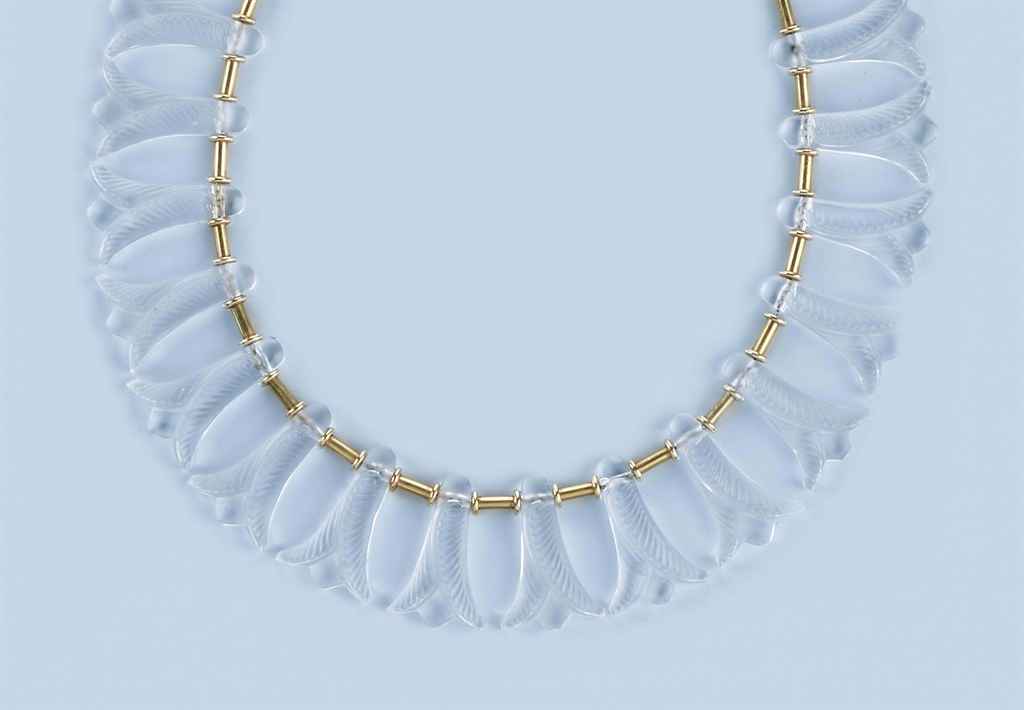

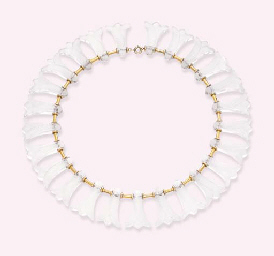


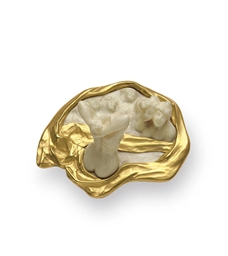


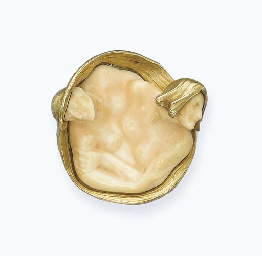

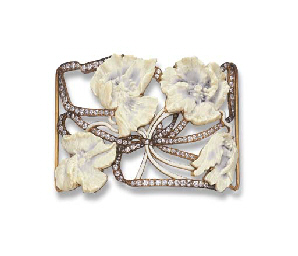
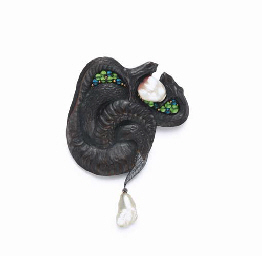



Testen Sie LotSearch und seine Premium-Features 7 Tage - ohne Kosten!
Lassen Sie sich automatisch über neue Objekte in kommenden Auktionen benachrichtigen.
Suchauftrag anlegen